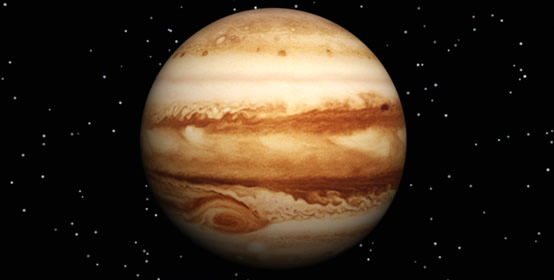
NASA team members could not hide their excitement when the Juno mission's spacecraft entered the orbit of the planet Jupiter on July 4th, 2016 just before 9 p.m. This happened during local time and required a tricky maneuver designed to slow down the spacecraft by more than 1,200 mph in order for it to be taken into Jupiter's gravitational pull. The world agrees this accomplishment was an amazing feat. This is the first spacecraft to use solar energy as power to another planet. Scientists agree more amazing scientific discoveries will be provided by the Juno spacecraft as it orbits the planet Jupiter.
The reason the planet Jupiter is the focus of so much attention is its dominance in the solar system. The size of the planet, as well as it being the first gas-giant planet to have come into existence, means it had significant influence on the formation of other planets. Scientists speculate Jupiter is the reason for the asteroid belt. It is also believed Jupiter has caused a number of comets to come into existence at the edge of the solar system. Jupiter has also prevented a number of comets from hitting the earth. The atmosphere of the planet is made of mostly helium and hydrogen and resembles the composition of the sun and stars.
The entire Juno spacecraft mission will cost over $1.1 billion. The journey from Earth to Jupiter took approximately five years. The spacecraft is now scheduled to travel around Jupiter for at least 20 months. At the end of this time, it will be forced to fall into Jupiter's dense and harsh atmosphere. This will cause it to burn up.
The main goal of the Juno spacecraft is understanding the evolution of the planet Jupiter. There will be approximately nine scientific instruments used as tools for the investigation. The presence of a solid planetary core will be examined. There will also be attempts to map the intense magnetic field on Jupiter. The atmosphere of the planet will be measured for the presence of ammonia and water. The auroras of Jupiter will also be observed. Scientists hope to gain an understanding of the role large planets play in forming the rest of the solar system. It is also believed that Jupiter will provide valuable knowledge when it comes to understanding other planetary systems discovered around stars in the universe.
Three different solar panels have been used to power the Juno spacecraft. These panels are arranged symmetrically around the spacecraft. When it broke free from the Earth's atmosphere, all three of the solar panels were deployed. One of the panels has three segments as well as a magnetometer. The other two panels each have four hinged segments. Each of the panes is 8.9 feet by 29 feet long. This makes them the largest solar panels used on any deep-space probe constructed by NASA. The solar panels were constantly in sunlight and will remain that way until the end of the spacecraft's mission. A central unit distributes the power and drives the spacecraft. It is used to generate power to operate experiment sensors, scientific instruments, as well as charging batteries and more. It has lithium-ion batteries that have been designed to function within Jupiter's environment.
There are a number of important questions scientists will try and answer. NASA doesn't know if Jupiter began its existence with a rocky planetary core and then obtained all the gas that currently makes up the planet. Scientist's want to know if it's possible Jupiter was formed with an unstable gas cloud. Another question concerning the planet is the amount of water it contains. They would like to measure the amount of oxygen that is available. There is speculation less oxygen is on Jupiter when compared to other objects in that area of the solar system. Scientists would also like to know how the eye of the planet stays so stable. Astronomers have seen the red spot or eye on Jupiter for centuries. Many speculate it could be a permanent thunderstorm. It's estimated the eye contains 300 mph winds and is three times the diameter of the Earth.
The Juno spacecraft will begin using its nine different scientific instruments late in August. This is when it will be in position for a close pass to Jupiter. The majority of the scientific work will begin during October. At this time, the spacecraft's engines will be used to place it into a 14-day scientific orbit. The Juno spacecraft is scheduled to do over 30 scientific orbits. It is then scheduled to be destroyed in Jupiter's atmosphere during February 2018.